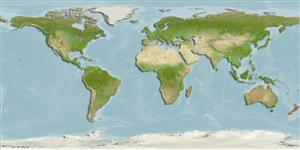Common names from other countries
>
Blenniiformes (Blennies) >
Tripterygiidae (Triplefin blennies) > Tripterygiinae
Etymology: Bellapiscis: Latin, bellum = war + Latin, piscis = fish.
More on author: Günther.
Environment: milieu / climate zone / depth range / distribution range
นิเวศวิทยา
เกี่ยวกับทะเล,น้ำเค็ม สัตว์น้ำหน้าดิน; ไม่มีการอพยพย้ายถิ่น; ระดับความลึก 0 - 5 m (Ref. 9003). Temperate
Southwest Pacific: endemic to New Zealand.
ขนาด / น้ำหนัก / Age
Maturity: Lm ? range ? - ? cm
Max length : 7.5 cm SL เพศผู้/กระเทย; (Ref. 9003)
Short description
สัณฐานวิทยา | ความยาวต่างๆ
เงี่ยงครีบหลัง (รวม): 18 - 21; ก้านครีบอ่อนที่หาง (รวม): 10-14; เงี่ยงครีบก้น 2; ก้านครีบอ่อนที่ก้น: 20 - 23
Facultative air-breathing (Ref. 126274); Adults occur in rock pools and surge zones. They may remain out of water under rocks or seaweed (Ref. 31184). They feed on mollusks and minute crustaceans, including barnacles. This agile species eludes predators by alternately remaining motionless, then rapidly darting to a new location. Feeding occurs even in the swash zone where the fish rapidly darts with the surge and clinging to the rock as the water recedes, often being left exposed on the damp open rock (Ref. 26966). Eggs are hemispherical and covered with numerous sticky threads that anchor them in the algae on the nesting sites (Ref. 240). Larvae are planktonic which occur primarily in shallow, nearshore waters (Ref. 94114). They breathe air when out of water (Ref. 31184).
Eggs are deposited over the undersurface of a rock where they are fertilized and guarded by the male (Ref. 9003).
Fricke, R., 1994. Tripterygiid fishes of Australia, New Zealand and the southwest Pacific Ocean (Teleostei). Theses Zool. 24:1-585. (Ref. 13227)
IUCN Red List Status (Ref. 130435)
CITES (Ref. 128078)
Not Evaluated
Threat to humans
Harmless
Human uses
การประมง: ไม่มีผลประโยชน์
ข้อมูลเพิ่มเติม
Age/SizeการเจริญเติบโตLength-weightLength-lengthLength-frequenciesความยาวต่างๆสัณฐานวิทยาตัวอ่อนพลวัตของสัตว์น้ำวัยอ่อนการทดแทนที่อุดมสมบรูณ์
อ้างอิงการเพาะเลี้ยงสัตว์น้ำประวัติการเพาะเลี้ยงสัตว์น้ำสายพันธุ์พันธุศาสตร์ElectrophoresesอัตราพันธุกรรมโรคการแปรรูปMass conversion
ผู้ร่วมมือรูปภาพหลายรูปStamps, Coins Misc.เสียงปลามีพิษ เช่น ปลาปักเป้าความเร็วรูปแบบการว่ายน้ำพื้นที่เหงือกOtolithsสมองวิสัยทัศน์
เครื่องมือ
Special reports
Download XML
แหล่งที่มาจากอินเตอร์เน็ต
Estimates based on models
Preferred temperature (Ref.
115969): 12.8 - 18.7, mean 16.1 (based on 114 cells).
Phylogenetic diversity index (Ref.
82804): PD
50 = 0.7500 [Uniqueness, from 0.5 = low to 2.0 = high].
Bayesian length-weight: a=0.00794 (0.00346 - 0.01822), b=3.08 (2.88 - 3.28), in cm Total Length, based on LWR estimates for this (Sub)family-body shape (Ref.
93245).
ระดับชั้นอาหาร (Ref.
69278): 3.5 ±0.4 se; based on diet studies.
ความสามารถในการกลับคืนสู่ปกติ (Ref.
120179): ความสูง, เวลาต่ำสุดที่จะทำให้ประชากรเพิ่มขึ้นเป็น 2 เท่าใช้เวลาน้อยกว่า 15 เดือน (Preliminary K or Fecundity.).
Fishing Vulnerability (Ref.
59153): Low vulnerability (10 of 100).
